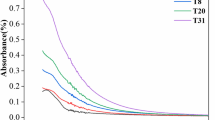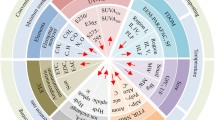Abstract
The information on molecular weight (MW) characteristics of DOM and relevant evolution behaviors during composting are limited. In this study, DOM extracted from co-composting of chicken manure and rice husks were comprehensively analyzed by using high-performance size exclusion chromatography (HPSEC) combined with a two-dimensional correlation spectroscopy (2D COS) to explore the evolution characteristics of MW of compost DOM. The HPSEC detected at UV of 254 nm and at fluorescence (FL) Ex/Em wavelengths (315/410, 270/455 nm) all showed a gradual increase in both weight-average and number-average MW for DOM, suggesting that the large MW fractions were continuously generated and polymerized during composting. The 2D COS applied on HPSEC-UV and -FL further identified the key active MW chromophoric (i.e., 0.5, 7.2. 9.5, 26.3, 30.7, and 83.9 kDa) and fluorophoric (i.e., 0.55 and 3.5 kDa) molecules that mainly participated in the transformation processes of compost DOM. Moreover, these active MW species were preferentially formed by the order of small to large molecules. A hetero-2D COS analysis disclosed the change sequence in the order of 0.5 and 7.2 kDa chromophores → 3.5 kDa fluorophores, and the 0.55 and 3.5 kDa fluorophores → 26.3 and 83.9 kDa chromophores.







Similar content being viewed by others
Data availability
All data generated or analyzed during this study in this article are available from the corresponding author on reasonable request.
References
Abid W, Mahmoud IB, Masmoudi S, Triki MA, Mounier S, Ammar E (2020) Physico-chemical and spectroscopic quality assessment of compost from date palm (Phoenix dactylifera L) waste valorization. J Environ Manag 264:110492
Castan S, Sigmund G, Hüffer T, Tepe N, von der Kammer F, Chefetz B, Hofmann T (2020) The importance of aromaticity to describe the interactions of organic matter with carbonaceous materials depends on molecular weight and sorbent geometry. Environ Sci Process Impacts 22:1888–1897
Che J, Bai Y, Li X, Ye J, Liao H, Cui P, Yu Z, Zhou S (2021) Linking microbial community structure with molecular composition of dissolved organic matter during an industrial-scale composting. J Hazard Mater 405:124281
Chen W, Westerhoff P, Leenheer JA, Booksh K (2003) Fluorescence excitation−emission matrix regional integration to quantify spectra for dissolved organic matter. Environ Sci Technol 37:5701–5710
Chen Y, Jiang Z, Zhang X, Cao B, Yang F, Wang Z, Zhang Y (2017) Variation in the humification degree of dissolved organic matter from cattle manure during composting as analyzed by ultraviolet-visible and fluorescence spectroscopy. J Environ Qual 46:1489–1499
Chen W, Teng C-Y, Qian C, Yu H-Q (2019) Characterizing properties and environmental behaviors of dissolved organic matter using two-dimensional correlation spectroscopic analysis. Environ Sci Technol 53:4683–4694
Coble PG (1996) Characterization of marine and terrestrial DOM in seawater using excitation-emission matrix spectroscopy. Mar Chem 51:325–346
Fellman JB, Hood E, Spencer RGM (2010) Fluorescence spectroscopy opens new windows into dissolved organic matter dynamics in freshwater ecosystems: a review. Limnol Oceanogr 55:2452–2462
Guo X, Li C, Zhu Q, Huang T, Cai Y, Li N, Liu J, Tan X (2018) Characterization of dissolved organic matter from biogas residue composting using spectroscopic techniques. Waste Manage 78:301–309
He X, Xi B, Wei Z, Guo X, Li M, An D, Liu H (2011) Spectroscopic characterization of water extractable organic matter during composting of municipal solid waste. Chemosphere 82:541–548
He X-S, Xi B-D, Li W-T, Gao R-T, Zhang H, Tan W-B, Huang C-H (2015) Insight into the composition and evolution of compost-derived dissolved organic matter using high-performance liquid chromatography combined with Fourier transform infrared and nuclear magnetic resonance spectra. J Chromatogr A 1420:83–91
He X-S, Yang C, You S-H, Zhang H, Xi B-D, Yu M-D, Liu S-J (2019) Redox properties of compost-derived organic matter and their association with polarity and molecular weight. Sci Total Environ 665:920–928
Huang M, Li Z, Huang B, Luo N, Zhang Q, Zhai X, Zeng G (2018) Investigating binding characteristics of cadmium and copper to DOM derived from compost and rice straw using EEM-PARAFAC combined with two-dimensional FTIR correlation analyses. J Hazard Mater 344:539–548
Huang W, Li Y, Liu X, Wang W, Wen P, Yu Z, Zhou S (2021) Linking the electron transfer capacity with the compositional characteristics of dissolved organic matter during hyperthermophilic composting. Sci Total Environ 755:142687
Ignatev A, Tuhkanen T (2019) Step-by-step analysis of drinking water treatment trains using size-exclusion chromatography to fingerprint and track protein-like and humic/fulvic-like fractions of dissolved organic matter. Environ Sci: Water Res Technol 5:1568–1581
Jiang Z, Lu Y, Xu J, Li M, Shan G, Li Q (2019) Exploring the characteristics of dissolved organic matter and succession of bacterial community during composting. Biores Technol 292:121942
Jokubauskaite I, Amaleviciute K, Lepane V, Slepetiene A, Slepetys J, Liaudanskiene I, Karcauskiene D, Booth CA (2015) High-performance liquid chromatography (HPLC)-size exclusion chromatography (SEC) for qualitative detection of humic substances and dissolved organic matter in mineral soils and peats in Lithuania. Int J Environ Anal Chem 95:508–519
Lee M-H, Han S-J, Lee YK, Ike IA, Ok YS, Hur J (2020) Enhancing copper binding property of compost-derived humic substances by biochar amendment: Further insight from two-dimensional correlation spectroscopy. J Hazard Mater 390:121128
Li M, Drosos M, Hu H, He X, Wang G, Zhang H, Hu Z, Xi B (2019) Organic amendments affect dissolved organic matter composition and mercury dissolution in pore waters of mercury-polluted paddy soil. Chemosphere 232:356–365
Liu B, Wu J, Cheng C, Tang J, Khan MFS, Shen J (2019) Identification of textile wastewater in water bodies by fluorescence excitation emission matrix-parallel factor analysis and high-performance size exclusion chromatography. Chemosphere 216:617–623
Liu X, Hou Y, Yu Z, Wang Y, Zhou S, Jiang B, Liao Y (2020) Comparison of molecular transformation of dissolved organic matter in vermicomposting and thermophilic composting by ESI-FT-ICR-MS. Environ Sci Pollut Res 27:43480–43492
Lv B, Xing M, Yang J, Qi W, Lu Y (2013) Chemical and spectroscopic characterization of water extractable organic matter during vermicomposting of cattle dung. Biores Technol 132:320–326
Mostofa KMG, Liu C-Q, Yoshioka T, Vione D, Zhang Y, Sakugawa H (2013) Fluorescent Dissolved Organic Matter in Natural Waters. In: Mostofa KMG, Yoshioka T, Mottaleb A, Vione D (eds) Photobiogeochemistry of organic matter: Principles and Practices in Water Environments. Springer, Berlin Heidelberg, Berlin, Heidelberg, pp 429–559
Musadji NY, Lemée L, Caner L, Porel G, Poinot P, Geffroy-Rodier C (2020) Spectral characteristics of soil dissolved organic matter: Long-term effects of exogenous organic matter on soil organic matter and spatial-temporal changes. Chemosphere 240:124808
Niu Q, Yan H, Meng Q, Wang S, Li G, Zhu Q, Li X, Li Q (2021) Hydrogen peroxide plus ascorbic acid enhanced organic matter deconstructions and composting performances via changing microbial communities. J Environ Manage 295:113126
Noda I (2016) Techniques useful in two-dimensional correlation and codistribution spectroscopy (2DCOS and 2DCDS) analyses. J Mol Struct 1124:29–41
Noda I, Ozaki Y (2004) Two-dimensional correlation spectroscopy—applications in vibrational and optical spectroscopy. John Wiley & Sons, Ltd
Song JZ, Huang WL, Peng PA, Xiao BH, Ma YJ (2010) Humic acid molecular weight estimation by high-performance size-exclusion chromatography with ultraviolet absorbance detection and refractive index detection. Soil Sci Soc Am J 74:2013–2020
Stedmon CA, Bro R (2008) Characterizing dissolved organic matter fluorescence with parallel factor analysis: a tutorial. Limnol Oceanogr Methods 6:572–579
Trubetskaya OE, Richard C, Patsaeva SV, Trubetskoj OA (2020) Evaluation of aliphatic/aromatic compounds and fluorophores in dissolved organic matter of contrasting natural waters by SEC-HPLC with multi-wavelength absorbance and fluorescence detections. Spectrochim Acta Part A Mol Biomol Spectrosc 238:118450
Wang Q, Ren X, Sun Y, Zhao J, Awasthi MK, Liu T, Li R, Zhang Z (2021a) Improvement of the composition and humification of different animal manures by black soldier fly bioconversion. J Clean Prod 278:123397
Wang S, Meng Q, Zhu Q, Niu Q, Yan H, Li K, Li G, Li X, Liu H, Liu Y, Li Q (2021b) Efficient decomposition of lignocellulose and improved composting performances driven by thermally activated persulfate based on metagenomics analysis. Sci Total Environ 794:148530
Wei Z, Wang X, Zhao X, Xi B, Wei Y, Zhang X, Zhao Y (2016) Fluorescence characteristics of molecular weight fractions of dissolved organic matter derived from composts. Int Biodeterior Biodegradation 113:187–194
Xiao X, Xi B-D, He X-S, Zhang H, Li D, Zhao X-Y, Zhang X-H (2019) Hydrophobicity-dependent electron transfer capacities of dissolved organic matter derived from chicken manure compost. Chemosphere 222:757–765
Yan L, Liu C, Zhang Y, Liu S, Zhang Y (2021) Effects of C/N ratio variation in swine biogas slurry on soil dissolved organic matter: content and fluorescence characteristics. Ecotoxicol Environ Saf 209:111804
Yang Y, Du W, Cui Z, Zhao T, Wang X, Lv J (2020) Spectroscopic characteristics of dissolved organic matter during pig manure composting with bean dregs and biochar amendments. Microchem J 158:105226
Yu Z, Liu X, Zhao M, Zhao W, Liu J, Tang J, Liao H, Chen Z, Zhou S (2019) Hyperthermophilic composting accelerates the humification process of sewage sludge: Molecular characterization of dissolved organic matter using EEM–PARAFAC and two-dimensional correlation spectroscopy. Biores Technol 274:198–206
Yuan D-H, An Y-C, He X-S, Yan C-L, Jia Y-P, Wang H-T, He L-S (2018a) Fluorescent characteristic and compositional change of dissolved organic matter and its effect on heavy metal distribution in composting leachates. Environ Sci Pollut Res 25:18866–18878
Yuan Y, Xi B-D, He X-S, Ma Y, Zhang H, Li D, Zhao X-Y (2018b) Insights into the redox components of dissolved organic matters during stabilization process. Environ Sci Pollut Res 25:13026–13034
Zhang S, Chen Z, Wen Q, Ma J, He Z (2016) Assessment of maturity during co-composting of penicillin mycelial dreg via fluorescence excitation-emission matrix spectra: Characteristics of chemical and fluorescent parameters of water-extractable organic matter. Chemosphere 155:358–366
Zhang D, Trzcinski AP, Luo J, Stuckey DC, Tan SK (2018) Fate and behavior of dissolved organic matter in a submerged anoxic-aerobic membrane bioreactor (MBR). Environ Sci Pollut Res 25:4289–4302
Zhu Q, Li G, Jiang Z, Li M, Ma C, Li X, Li Q (2020) Investigating the variation of dissolved organic matters and the evolution of autotrophic microbial community in composting with organic and inorganic carbon sources. Biores Technol 304:123013
Funding
This work was supported by the Natural Science Foundation of Anhui Province, China (Grant number 2108085MD140); the Science and Technology Major Project of Anhui Province (Grant number 201903a06020023); the Project Funding for Young Talents in College of Anhui Province (Grant number gxyqZD2021126); and the Natural Science Foundation of the Anhui Provincial Education Department (Grant number KJ2020A0050).
Author information
Authors and Affiliations
Contributions
Xufang Yu: writing—original draft, formal analysis, methodology. Ao Cheng: investigation, software, data curation. Dan Chen: investigation, data curation. Ting Li: investigation. Xingjun Fan: methodology, supervision, funding acquisition, writing—review and editing. Xiang Wang: data curation. Wenchao Ji: software, formal analysis. Jianfei Wang: methodology, writing—review and editing. Lantian Ren: writing—review and editing.
Corresponding author
Ethics declarations
Ethics approval and consent to participate
Not applicable.
Consent for publication
Not applicable.
Competing interests
The authors declare no competing interests.
Additional information
Responsible Editor: Thomas D. Bucheli
Publisher's note
Springer Nature remains neutral with regard to jurisdictional claims in published maps and institutional affiliations.
Supplementary Information
Below is the link to the electronic supplementary material.
Rights and permissions
Springer Nature or its licensor (e.g. a society or other partner) holds exclusive rights to this article under a publishing agreement with the author(s) or other rightsholder(s); author self-archiving of the accepted manuscript version of this article is solely governed by the terms of such publishing agreement and applicable law.
About this article
Cite this article
Yu, X., Cheng, A., Chen, D. et al. Insight into the evolution characteristics on molecular weight of compost dissolved organic matters using high-performance size exclusion chromatography combined with a two-dimensional correlation analysis. Environ Sci Pollut Res 30, 37197–37207 (2023). https://doi.org/10.1007/s11356-022-24922-5
Received:
Accepted:
Published:
Issue Date:
DOI: https://doi.org/10.1007/s11356-022-24922-5




